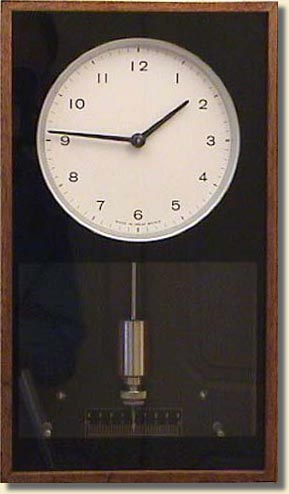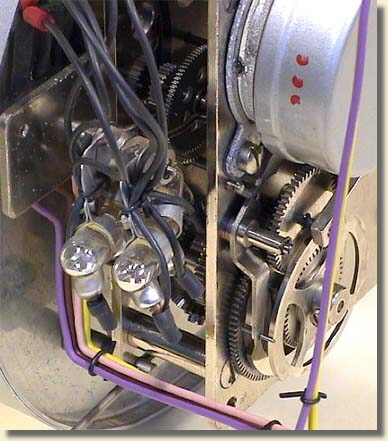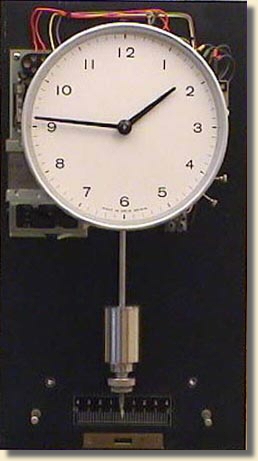
ECS Memory Master Clock
 |
Around 1962, English Clock Systems Ltd, in conjunction with Gents of Leicester, developed a master clock which used a half-second pendulum, and which generated alternate polarity pulses once per minute for slave dials. This suited many of the Continental European designed slave dials available at that time. European clock designers had devised the alternate polarity system (where the slave is sent one pulse of positive polarity and the next pulse of the opposite polarity) to overcome any problems of a double pulse being sent in error and upsetting the synchronisation of the slave dials. With alternate polarity slaves, repeated pulses of the same polarity cannot advance the slave dial.
ECS named their clock the "Memory Master" and Gents called theirs the "Chronopher". |
| The 'Memory Master' clock is a clever combination of
ac mains power and conventional clockwork. The pendulum controls a dead beat
escapement powered by a spring in a barrel. The hands of the master clock's dial
are driven mechanically from this clockwork train. Every one minute, a
synchronous electric motor is allowed to run to rewind the spring and to operate
switches to provide an alternate polarity pulse to the slave dials.
If the ac mains power fails, the clock continues to run on its spring reserve for up to 10 hours, and the master clock's dial will continue to show the correct time. The slave dials will all stop as they are powered electrically by 24 volts derived from the ac mains. However, a mechanical memory stores the duration of the power failure, and, on restoration of mains power, the synchronous motor runs continuously to update the slaves until they show the correct time. The mains transformer can be seen behind the left side of the dial. The pendulum is of Invar, and the accuracy of the clock is high. |
|
 |
The ac mains powered rewind motor is on the back of the movement. (In the photo, its cover has the three red dots on.)
Below the motor the two memory wheels have smooth circumferences, each with a recess cut to a smaller diameter for part of their circumference, and are geared together at 12:1. The outer wheel is the 'minutes' wheel and inner is the 'hours' wheel. The lever with pins straddling the two memory wheels will only drop into both recesses cut into the circumferences of the wheels when the memory has 'unwound' to zero. This then causes the synchronous motor to be stalled and stops the rewinding of the going spring. During the next minute under the power of the spring, the memory wheels continue to turn and lift the lever with pins onto the larger diameter part of the minute wheel, releasing the motor again. The two mercury filled glass switches provide alternate polarity pulses of 24 volts dc for the slave dials. The switches are each tilted individually on alternate minutes by pins on a wheel, thus switching the slave current one way then the other. |

